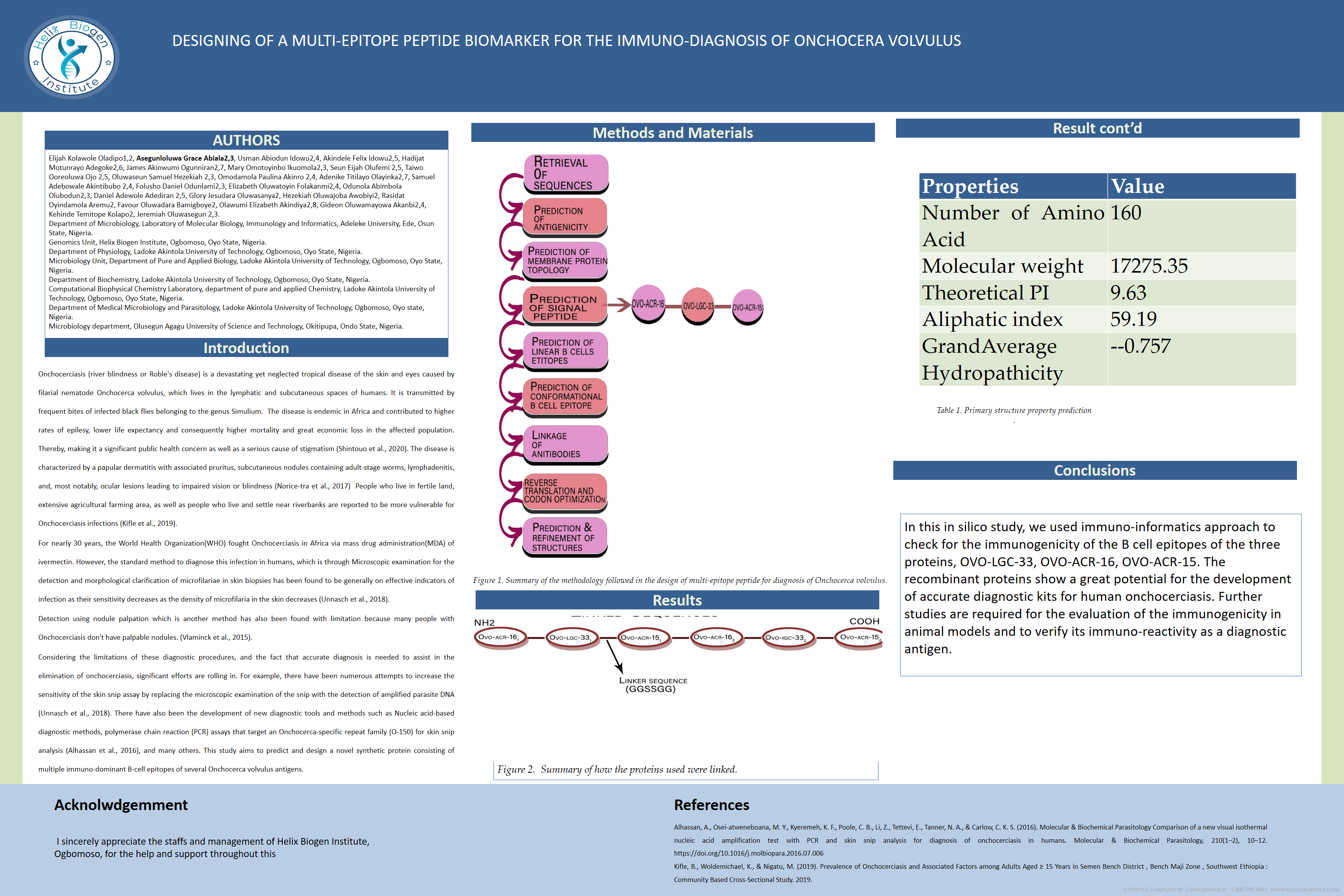Grace Asegunloluwa Abiala
Conference 2022 Poster Presentation
Project title
Design of a multi-epitope peptide biomarker for the immuno-diagnosis of onchocera volvolus
Authors and Affiliations
Asegunloluwa Grace Abiala2,3 Usman Abiodun Idowu2,4, Akindele Felix Idowu2,5 , Hadijat Motunrayo Adegoke2,6, James Akinwumi Ogunniran2,7, Mary Omotoyinbo Ikuomola2,3, Seun Elijah Olufemi 2,5, Taiwo Ooreoluwa Ojo 2,5, Oluwaseun Samuel Hezekiah 2,3, Omodamola Paulina Akinro 2,4, Adenike Titilayo Olayinka2,7, Samuel Adebowale Akintibubo 2,4, Folusho Daniel Odunlami2,3, Elizabeth Oluwatoyin Folakanmi2,4, Odunola Abimbola Olubodun2,3, Daniel Adewole Adediran 2,5, Glory Jesudara Oluwasanya2, Hezekiah Oluwajoba Awobiyi2, Rasidat Oyindamola Aremu2, Favour Oluwadara Bamigboye2, Olawumi Elizabeth Akindiya2,8, Gideon Oluwamayowa Akanbi2,4, Kehinde Temitope Kolapo2, Jeremiah Oluwasegun 2,3, Elijah Kolawole Oladipo1,2.
1. Department of Microbiology, Laboratory of Molecular Biology, Immunology and Informatics, Adeleke University, Ede, Osun State, Nigeria.
2. Genomics Unit, Helix Biogen Institute, Ogbomoso, Oyo State, Nigeria.
3. Department of Physiology, Ladoke Akintola University of Technology, Ogbomoso, Oyo State, Nigeria.
4. Microbiology Unit, Department of Pure and Applied Biology, Ladoke Akintola University of Technology, Ogbomoso, Oyo State, Nigeria.
5. Department of Biochemistry, Ladoke Akintola University of Technology, Ogbomoso, Oyo State, Nigeria.
6. Computational Biophysical Chemistry Laboratory, Department of Pure and Applied Chemistry, Ladoke Akintola University of Technology, Ogbomoso, Oyo State, Nigeria.
7. Department of Medical Microbiology and Parasitology, Ladoke Akintola University of Technology, Ogbomoso, Oyo State, Nigeria.
8. Microbiology Department, Olusegun Agagu University of Science and Technology, Okitipupa, Ondo State, Nigeria.
Abstract
Background
The plan to eliminate Onchocerciasis caused by the parasitic nematode Onchocerca volvulus has faced numerous challenges. Despite sweeping efforts and the creation of various control programs, O. volvulus infection control success has been limited to a few societies in Africa. There is no doubt that accurate diagnosis is necessary to conduct surveillance for the identification of the infection as the public health goal has advanced from control to elimination of the disease. The accuracy of the current diagnostic kits has proven to be insufficient as well as difficult to standardize. Hence, we opted to design and model a more sensitive and specific biomarker construct for the accurate diagnosis of onchocerciasis.
Methods
The total number of sixty (60) genes were retrieved from Wormbase server. The genes were subjected to antigenicity test and they were further subjected to topology, signal peptide, and B cell epitope prediction using bioinformatics tools. Three (3) genes (OVO-ACR-15, OVO-ACR-16, and OVO-LGC-33) appeared as the most antigenic epitopes which suggested the potentiality of developing an effective diagnostic kit, and the selected epitopes were linked together with linkers.
Results
Overall, the projected construct had a length of 160, predicting its stability across a large temperature range, and 74.359 % of the residue was discovered in a desirable region on the Ramachandran plot. The GRAVY (Grand average of hydropathicity) value of this construct is -0.757 and it explains that the construct is hydrophilic in nature.
Conclusions
In an attempt to help achieve the Onchocerciasis elimination goal, immuno-informatics analysis shows that this predicted design can lay a theoretical basis to develop a potential and effective diagnostic kit for human Onchocerciasis.

